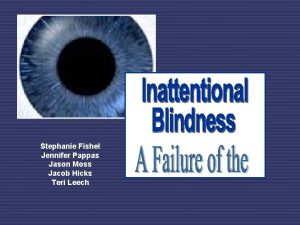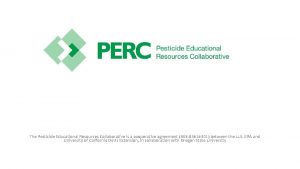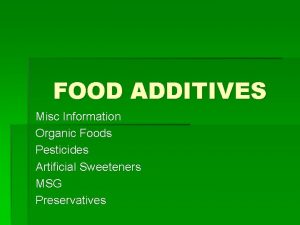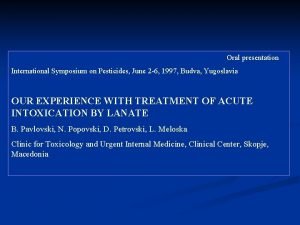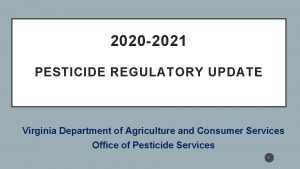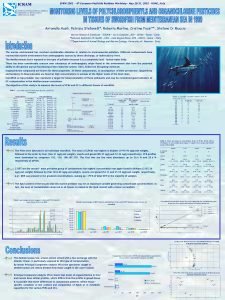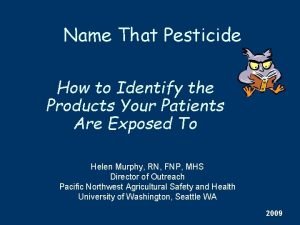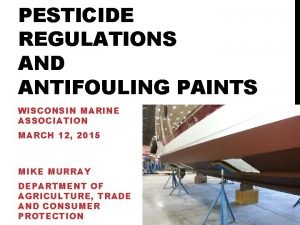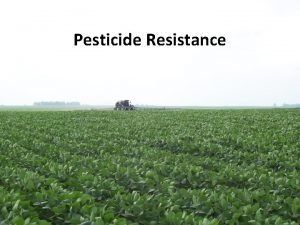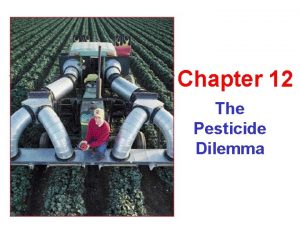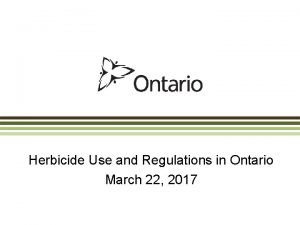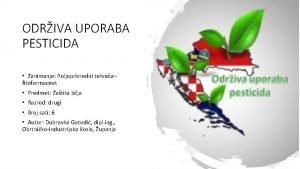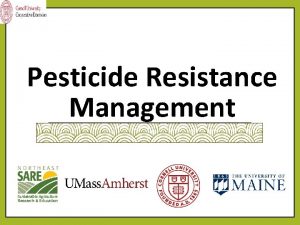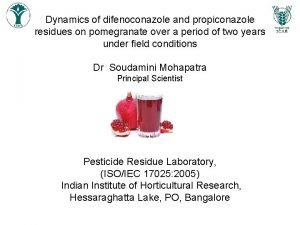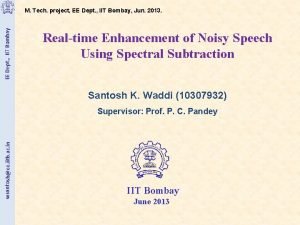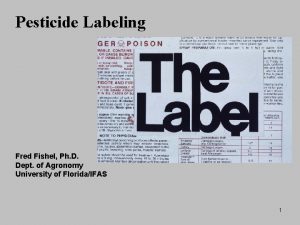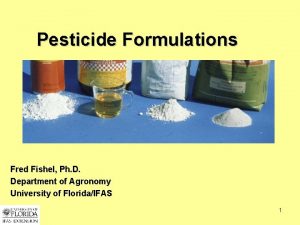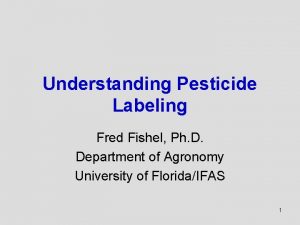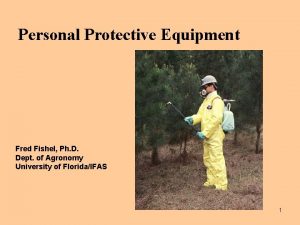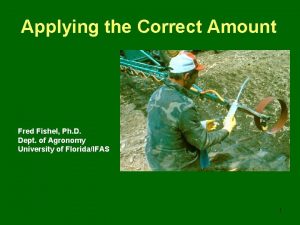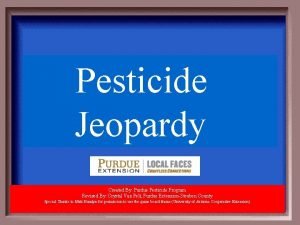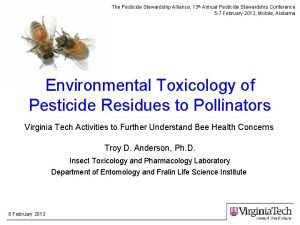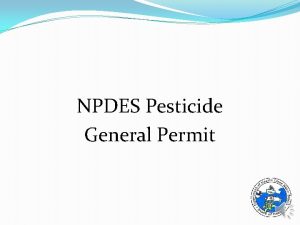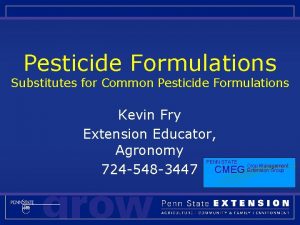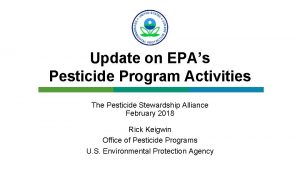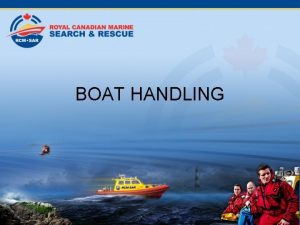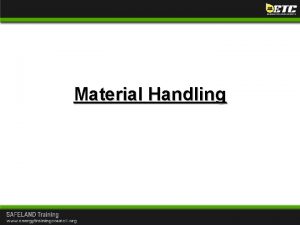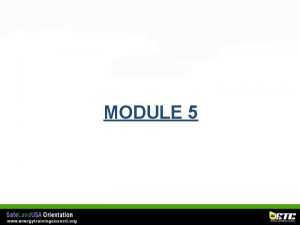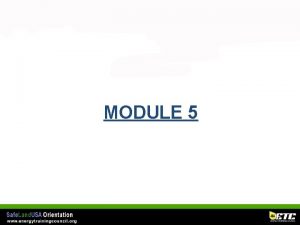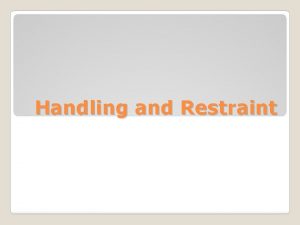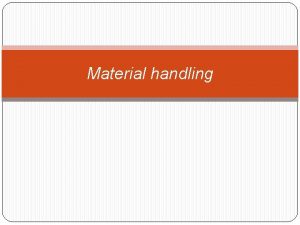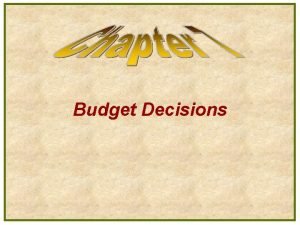Pesticide Handling Decisions Fred Fishel Ph D Dept

































- Slides: 33

Pesticide Handling Decisions Fred Fishel, Ph. D. Dept. of Agronomy University of Florida/IFAS 1

Information that will be presented throughout this presentation is based upon Unit 8 in the Florida Core Manual, Applying Pesticides Correctly. You can purchase a copy to keep on hand for a reference from the IFAS Extension Bookstore. 2

Pesticide Handling Decisions • Safety is the first priority – The environment – The applicator – Others 3

Has the label been read? 4

Avoid Exposure • Personal belongings away from pesticides • Wash gloves prior to removal • Exposure can also occur when… – Using the toilet – Cleaning up spills – Repairing equipment – Transporting – Storing – disposing 5

What PPE is needed? 6

Is the application equipment in good working order? 7

Avoid accidental pesticide spread. 8

Instruct all handlers. 9

Being Prepared for an Emergency • Personal decontamination equipment • Spill cleanup equipment • First aid equipment 10

Keep people out of the treatment area. 11

Misused pesticides… • Damage to the target site and environment • Wasted material • Control failure 12

When in doubt, ask for help. 13

Many pesticides are available in more than one formulation. 14

Some formulations cause harm to surfaces, plants and animals: • ECs: stain, skin-absorbed • Dusts: leave visible residues • Fumigants: kill all organisms 15

Available equipment may dictate choice of formulation for the job. 16

Will offsite movement be a factor? Plant injury due to drift Fish kill from pesticide run-off 17

Some formulations are more hazardous to people. Fumigants are highly toxic to a wide range of organisms. ECs are more readily absorbed by skin. 18

Formulation selection may depend upon pest type. Some pests require that a wide area be treated while others can be managed with a specifically placed pesticide. 19

The final decision on selection may be cost. Diluted, ready-to-use products are more costly than concentrated forms. 20

Conditions of the application site affects: • • • The effectiveness of the application The applicator Those under applicator’s supervision Other people who may be in the area The environment 21

Treated Spaces Indoor spaces for treatment should be well-sealed. 22

Soil Treatment Soils with high organic matter and fine particle size may require higher rates for effective pest control. 23

Plant Surfaces Plants with flat broad leaves tend to hold pesticides on their surfaces longer than long and narrow leaves. 24

Other Surfaces • Pesticides run off: – Nonporous surfaces – Upright, slanted • Pesticides saturate: – Porous surfaces such as wood, concrete and fabric 25

Surface Moisture Pesticides work best with adequate soil moisture opposed to dry conditions. 26

Temperature, sunlight, humidity • Slow activity: – Low temps – Direct sunlight can degrade pesticides – Low humidity • Fast activity: – Higher temps – Lower sunlight – High humidity 27

Pesticide Vaporization • Low humidity • High temps 28

Rain or Irrigation • Advantageous: if label calls for “watering in” • Harmful – can cause washing off surfaces and off-site movement 29

Air Movement • Can result in drift • Can be controlled in some environments such as greenhouses 30

Scheduling Applications • When possible, consider: – When people will not be in the area – When it’s cooler – When wind is minimal 31

Avoid Heat Stress • Factors: – Temperature, humidity, air movement, sun – Workload – PPE – Water – Scheduling 32

Photo Credits • • • University of Missouri University of Georgia IFAS Communication Services University of Nebraska Purdue University Mention of trade names in this presentation is solely for providing specific information. It is not a guarantee or warranty of the products named, and does not signify that they are approved to the exclusion of others of suitable composition. Use pesticides safely. Read and follow directions on the manufacturer’s label. Fred Fishel, Ph. D. Department of Agronomy University of Florida/IFAS Copyright 2005 University of Florida 33
 Decisions decisions decisions poster
Decisions decisions decisions poster Gene fishel
Gene fishel Stephanie fishel
Stephanie fishel Stephen fishel
Stephen fishel Screening decisions and preference decisions
Screening decisions and preference decisions Pesticide educational resources collaborative
Pesticide educational resources collaborative Msg pesticide
Msg pesticide Lanate pesticide
Lanate pesticide Virginia pesticide registration
Virginia pesticide registration European pesticide residue workshop
European pesticide residue workshop Pesticide classification chart
Pesticide classification chart Wisconsin pesticide applicator license
Wisconsin pesticide applicator license Pesticide resistance
Pesticide resistance Types of pesticides
Types of pesticides Pesticide warning signs ontario
Pesticide warning signs ontario Tablica za pesticide
Tablica za pesticide Xxxxxxxxxx xxxxxxxxx
Xxxxxxxxxx xxxxxxxxx Agriculture pesticide difenoconazole
Agriculture pesticide difenoconazole Bromocicloesano
Bromocicloesano Affiliate disclodures
Affiliate disclodures Dept of education
Dept of education Ohio dept of developmental disabilities
Ohio dept of developmental disabilities Department of agriculture consumer services
Department of agriculture consumer services Iit
Iit Central islip fire dept
Central islip fire dept Hoe dept
Hoe dept Mn dept of education
Mn dept of education Pt dept logistik
Pt dept logistik La revenue dept
La revenue dept Florida dept of agriculture and consumer services
Florida dept of agriculture and consumer services Affiliation poster
Affiliation poster Gome dept
Gome dept Finance department organizational chart
Finance department organizational chart Dept ind onegov
Dept ind onegov


